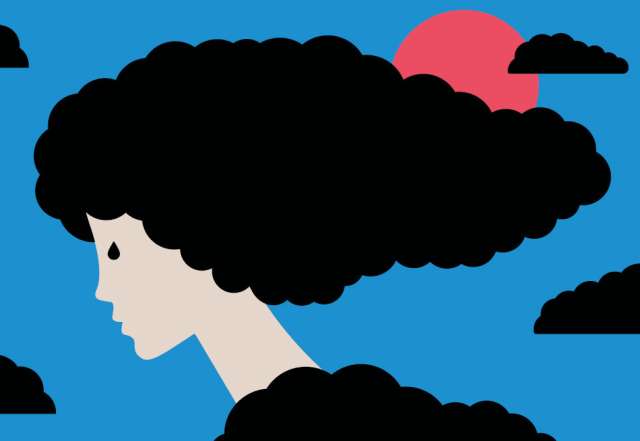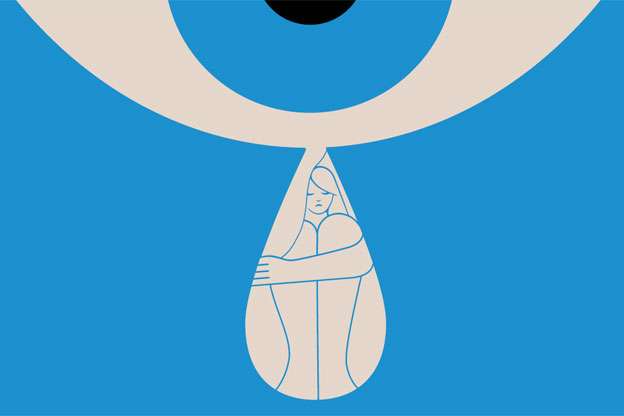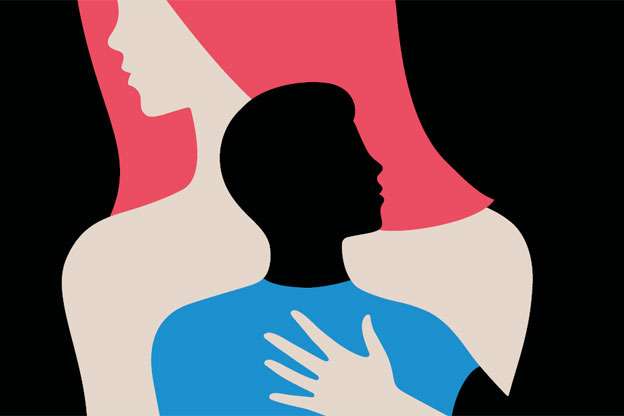There is an epidemic of sadness among teenagers, with one-in-10 — including one-in-three girls and 22% of LGBTQ+ youths — having seriously contemplated or attempted suicide in 2021. What’s going on? And what can be done about it?
By Dan Gordon
WHEN THE CENTERS FOR DISEASE CONTROL AND PREVENTION (CDC) released a report in February that evinced a bleak picture of teen emotional life — particularly among adolescent girls — alarms went off across the country.
“Teen Girls Report Record Levels of Sadness,” read the headline in The New York Times. “America’s Teenage Girls Are Not OK,” said The Atlantic magazine. “Teen Girls ‘Engulfed’ In Violence and Trauma,” declared the Washington Post.
The CDC’s biennial Youth Risk Behavior Survey, which tracks the health and well-being of the nation’s high school students, examined the state of teen life in 2021, the first full year after the start of the COVID-19 pandemic. Among the key points: More than 40% of the survey respondents reported feeling so sad or hopeless that they couldn’t engage in their regular activities for at least two weeks during the previous year, and one-in-10 had attempted to end their life.
Girls and minoritized youths reported suffering the most. Nearly three-in-five teen girls (57%) said they’d felt persistently sad or hopeless in 2021, double the rate of boys and an increase of nearly 60% over the last decade. Nearly one-in-five girls experienced sexual violence. Almost one-in-three seriously contemplated suicide. “America’s teen girls are engulfed in a growing wave of sadness, violence and trauma,” Debra Houry, MD, the CDC’s chief medical officer and deputy director for program and science, said at a press conference upon the report’s release.
Among LGBTQ+ youths [the survey asked about sexual orientation, but not gender identity], nearly 70% reported persistent feelings of sadness or hopelessness during the past year, with more than 50% experiencing poor mental health over the last 30 days. Twenty-two percent had attempted suicide in the past year.
These and other disturbing trends began well before COVID-19 upended the lives of America’s youths. Each Youth Risk Behavior Survey since 2011 has revealed more mental health problems than the previous one. Suicide deaths spiked 45% in the decade leading up to the pandemic, with disproportionate increases among members of minority groups. Pre-pandemic, approximately 8% of high school students reported a suicide attempt in the previous year.
“More sadness and depression among teens was a trend that was already brewing, in combination with fewer and fewer resources for prevention and mental health treatment, as well as easier access to potentially lethal methods,” says Natalia Ramos, MD (RES ’15, FEL ’17), MPH, medical director of the UCLA Stress, Trauma, and Resilience (STAR) Clinic, and of EMPWR (empower), an initiative of the UCLA Division of Population Behavioral Health designed to promote well-being and resilience in LGBTQ+ children, teens and adults. “Then it was all heightened and accelerated by the pandemic.”

The wrath of COVID-19 was widely felt, and not evenly distributed. For most teens, the social isolation and missed milestones hit hard, but lower-income families were more likely to bear the extra burdens of economic and housing instability. Many experienced serious illnesses and losses of loved ones. “Being a teenager is difficult in the best of times,” notes Dr. Ramos, assistant clinical professor of psychiatry and biobehavioral sciences in the Jane and Terry Semel Institute for Neuroscience and Human Behavior at UCLA. “When you mix in these additional challenges, it’s not surprising where we are.”
Joan Asarnow, PhD, professor of psychiatry and biobehavioral sciences and director of the UCLA Center for Adolescent Suicide and Self-Harm Treatment and Prevention, says she and her colleagues braced for the worst at the dawn of the pandemic, but their fears didn’t immediately materialize. “For the first year or so, there was actually a reduction in suicide deaths for the total U.S. population, and people we were following in our programs appeared less ill than before,” she says. Dr. Asarnow suspects that was because, in the short term, at-risk teens felt some relief from the removal of school stressors.
But the latest CDC numbers confirm that any respite was short-lived. “With these vast and constantly changing disruptions, and the lack of stability, kids, who are our most vulnerable, really suffered,” says Dr. Asarnow, director of the UCLA Youth Stress and Mood Program within the Semel Institute, which develops and evaluates treatments and services for depression and suicide prevention in children and adolescents. “Meanwhile, with schools having to do all they could just to educate children and adolescents, think of all the mental health support they couldn’t offer.”
Even as schools struggled to transition to online classrooms, the pandemic placed a pause on the social-emotional component and introduced a heightened level of uncertainty about the future, notes Benjamin N. Schneider, MD (RES ’12, FEL ’13), associate professor of psychiatry and biobehavioral sciences. What initially looked like two weeks of isolation stretched to nearly two years. During that time, social tensions and protests erupted following the police killing of George Floyd. And as pandemic restrictions eased, students returned to a world in which gun violence has become all too common.
“Part of a parent’s job is to teach children that the world is a relatively safe place,” says Dr. Schneider, medical director of the Achievement Behavior Cognition (ABC) Day Treatment Program in the Stewart and Lynda Resnick Neuropsychiatric Hospital at UCLA, which sees school-age children with a range of developmental, social, cognitive and emotional disorders. “It’s become much harder to do that.” To be sure, the disturbing trends predating the pandemic point to the need to address concerns unrelated to the coronavirus. Yet, the woes afflicting America’s teens cannot be attributed entirely to mental illness.
ADOLESCENCE WAS NEVER EASY. But Dr. Ramos points out that new developments, both biological and social, appear to be contributing to the greater distress. “Teens are hitting puberty earlier and earlier with each generation, so teen brains are being subjected to influences of mood and socialization changes that they’re less prepared for,” she says. “With the pervasive, 24/7 access to information, they’re much more aware of stressors, without the cognitive and emotional preparation to process them in healthy ways. It’s also become harder for parents to control what their teens have access to, or to discuss it with them, given this constant barrage of information from multiple platforms.”
Why these developments seem to weigh more heavily on the psyches of girls than boys is a complicated question. In the CDC survey, female students fared worse than males across all measures of mental health, substance use, experiences of violence and suicidal thoughts and behaviors — with one notable exception. “Teen girls have higher rates of suicidal ideation; suicide attempts; and non-suicidal, self-injurious behavior,” Dr. Asarnow says. “But boys die from suicide at a much higher rate.”
Jocelyn Meza, PhD, assistant professor of psychiatry and biobehavioral sciences and a teen-suicide researcher, points to two key factors contributing to the higher rates of female distress. “Girls in the second decade of life experience more internalizing symptoms, including depression and anxiety,” says Dr. Meza, associate director of the UCLA Youth Stress and Mood Program. “They tend to value social relationships more than boys, which means they’re affected more by interpersonal problems, victimization and feeling left out. There are also so many conflicting societal messages about what girls are supposed to be, and some girls feel that if they don’t meet those ideals something is wrong with them.”
Another factor is the emergence of social media as a mainstay in the lives of most teens. In the CDC survey, one-in-five girls reported having been cyberbullied, nearly double the proportion of boys. “It used to be that when you were bullied, it was in school, and you knew who it was,” Dr. Meza says. “Now, many young girls are victimized without even knowing who the perpetrator is.” Social media is a popular culprit for those seeking to assign blame for the rising levels of teen sadness. The UCLA experts say it’s more of a mixed bag. Many youths benefit from the increased opportunities to connect positively with peers; certainly, it offered relief from pandemic-induced isolation. But the documented negative effects of social media, beyond the cyberbullying, include reductions in face-to-face interaction, poorer-quality sleep and the perils of social comparison. “Teens may not necessarily post when they are alone or feeling low,” Dr. Schneider says. “They may be more likely to post during pleasurable activities — when they are out with friends or having a good time. That gives some of my patients the idea that they’re not measuring up.”

As it pertains to suicide, the supercharged era of online information and interaction has the potential to fuel a contagion effect — an association between exposure to peers who have attempted suicide or engaged in self-harm and higher rates of suicide and suicidal thinking. Dr. Asarnow notes that this can also occur through media exposure. In 2019, she and other mental health experts noted that many teens viewed the Netflix series 13 Reasons Why, which dramatized teen suicide, bullying and rape and offered scenes that may discourage youths from going to a school counselor for help, an important potential protective factor when teens are in acute distress. “Kids were watching it and talking about it,” Dr. Asarnow says. “And studies showed a 30% increase in teen suicide deaths around the time it was released.” While these data do not prove a causal relationship between viewing the series and suicide deaths, the numbers raise serious concern and support the value of reducing media exposure to suicide-related content in vulnerable teens, particularly when viewed without the support of a protective adult who can help the teen to process the material.
“The contagion phenomenon with suicides used to be more confined,” Dr. Schneider says. “People’s networks are much larger now. This can also extend to the experience of trauma — when kids see reports of schools getting locked down after shootings, they have to live with that knowledge, and some experience trauma vicariously.”
Dr. Ramos believes the ubiquity of hurtful social messaging in a highly polarized environment can take a particular toll on minoritized youths. “There’s so much racist, sexist, transphobic and homophobic content, even in mainstream media,” she says. “And many youths tend to internalize things that they hear about their identities being negative or unworthy.” Compounding the problem is the all-too-common experience and enduring impact of trauma from adverse childhood events — neglect, violence and abuse, poverty and homelessness, immigration stress, structural racism, sexism, homophobia, transphobia and more, all of it accentuated in the era of COVID-19. In the STAR program, Dr. Ramos says she has seen an uptick in both the number of traumatic stressors families are coping with and their intensity.
All of this comes at a time when access to mental health treatment and preventive services is sorely lacking. “For decades, we have had limited education, funding and resource allocation,” Dr. Ramos says. “We’re seeing the consequences of that, especially for less-resourced youths, with this tinderbox of factors all stacking up.”
Dr. Schneider notes that seeing a child and adolescent psychiatrist in the U.S. often requires spending months on a waiting list. “As a result, rather than treating people near the beginning of the problem, we’re having to react to dire circumstances in acute-care settings and emergency rooms,” he says.
Another access-related trend is also troubling. Suicide-prevention experts point out that when a person is contemplating ending their life, having access to lethal means substantially elevates the risk. And with nearly 400 million privately owned firearms in the U.S., it’s become all too easy for youths to act on what might represent a fleeting thought.
“Developmentally, children don’t have a fully developed prefrontal cortex, which is the part of the brain we use to put on the brakes and not act impulsively,” Dr. Meza says. And it’s not just the easy access to guns. “There are websites now with detailed instructions about how to ‘successfully’ end your life,” Dr. Meza says. “And we know kids are always online.”
THERE’S NO GETTING AROUND THE BLEAK NATURE OF THE CDC FINDINGS. But Dr. Asarnow is able to offer one optimistic point. “The good news is, we actually know what to do about this,” she says. “Community-based suicide prevention works.”
She points out that the federal Garrett Lee Smith Memorial Act, first signed into law in 2004 and most recently reauthorized in 2022, has provided grants to counties, states and tribes to implement community-specific suicide-prevention programs for at-risk teens. Evaluations of the programs have found that counties that implemented evidence-informed suicide-prevention care through Garrett Lee Smith saw significantly fewer suicide deaths and attempts. In March, Dr. Meza, Dr. Asarnow and colleagues published a review of 18 large studies that have evaluated interventions aimed at reducing suicide and self-harm in youths ages 12-to-18. They found several common threads in the programs that showed improvements, including integration of parents or other family caregivers in the therapy, an emphasis on relationship-building and teaching skills such as emotional regulation, development of a safety plan for coping in times of distress and restrictions on access to lethal means. The UCLA Youth Stress and Mood Program has conducted key studies showing the positive effect of dialectical behavioral therapy (DBT), which teaches teens skills that include emotional regulation and distress tolerance, as well as strategies for building a better life. In multisite research led by Dr. Asarnow at UCLA, DBT reduced self-harm and suicidal behavior in teens at high-risk for suicide and self-harm. “When emotional regulation improved, the kids got better,” Dr. Asarnow says. “We’re all going to experience pain and stress, so as parents and therapists, we need to help our kids tolerate that.”

Involving parents in the treatment contributes to what Dr. Asarnow calls a “protective seatbelt” — a circle of support around the child that provides a buffer against acting out on feelings of self-harm during the toughest times. Her program counsels parents on reducing family conflict, and on the do’s and don’ts of communication with their child. For example, gentle criticism such as, “Your room is messy; I’d like you to clean it up,” is OK, but statements like “You are the sloppiest person on Earth” don’t help the depressed teen. The protective seatbelt ideally extends beyond the parents to include other trusted and caring adults — including relatives, teachers, coaches and primary care providers — in whom the teen feels comfortable confiding. “Parents shouldn’t be offended if their child goes to another adult; just make sure their life is populated with people they trust,” Dr. Asarnow says.
Among adolescents, white males are the most likely to die by suicide, but Black and Latino teens have the highest rate of suicide attempts, with trends moving in the wrong direction. In the Health Equity & Access Research and Treatment (HEART) lab directed by Dr. Meza, she and her colleagues focus on understanding the social-cultural predictors of suicide for adolescents and young adults, with the goal of promoting their inclusion in culturally informed treatments. This includes addressing common experiences such as racism, discrimination and acculturation-related factors.
“For Black, Latino, LGBTQ+ and other kids from groups that experience marginalization, predictors include a sense of not having a place in the world,” Dr. Meza says. “Having a strong racial and ethnic identity, a sense of belonging within a community and civic engagement all serve as protective factors.” Given the barriers to accessing community-based mental health care, particularly among low-income families, the UCLA experts say any solution to the growing crisis has to bring mental health treatment and prevention services to the places where teens spend their time. School-based health and wellness centers play a critical role in providing access to mental health services for families that face insurance, transportation and other barriers. “We’ve known for a long time that schools are the place where most youths receive mental health services, especially in under-resourced communities,” says Roya Ijadi- Maghsoodi, MD (RES ’12, FEL ’14), assistant professor of psychiatry and biobehavioral sciences, who studies the delivery of mental health services in schools.
Dr. Ijadi-Maghsoodi and her UCLA colleagues have worked closely with the Los Angeles Unified School District to bring evidence-based mental health services to schools. To meet the needs of low-income, predominantly minoritized LAUSD students who have experienced trauma, her team has worked with district partners to adapt and implement a resilience- building curriculum originally developed at UCLA for military-connected families.
The Focus Resilience Curriculum, delivered in the classroom setting and provided to both students and parents, teaches skills that include emotional regulation, goal setting, empathy and communication. In addition to reporting improvements on measures of resilience, problem-solving and empathy, Dr. Ijadi-Maghsoodi and her colleagues have found that the curriculum enhances connections among students and helps to destigmatize mental health issues. Among the most promising developments for promoting mental health within schools is the increasing emphasis on programs that build peer support. “Peers play an important role in a teen’s life, and we want students to be able to talk to each other about mental health and normalize help-seeking behavior,”
Dr. Ijadi-Maghsoodi explains. Programs have been developed to train high school students in how to recognize and help a peer during times of high distress. Dr. Ijadi-Maghsoodi says normalizing discussions about mental health should be a priority for the adult population, as well. “We’re living in stressful times, and parents need to know it’s OK to reach out for mental health support for themselves if they need it,” she says.

WHEN FIRST MEETING WITH PARENTS OF CHILDREN WHO ENTER THE ACHIEVEMENT BEHAVIOR COGNITION PROGRAM, Dr. Schneider stresses the important role they will play in navigating their child to a better place. “If there’s turbulence on an airplane and the captain comes on the loudspeaker and calmly says everything is going to be OK, the passenger’s reaction is going to be very different than if they hear the captain in a state of panic,” Dr. Schneider says.
But too many parents are hurting. In an opinion piece in the Washington Post the week the CDC findings were released, journalist Kate Woodsome noted that in 2020, more than 50 million adults had a mental illness such as anxiety, depression or bipolar disorder. More than 60% of the adult population experienced trauma as children, challenging their ability to remain attentive and resourceful for their own kids. “There is a frantic search for ways to stop kids from hurting,” Woodsome wrote. “But if we want to make any lasting difference, it is us, the adults, who need an intervention.”
Dr. Asarnow agrees. “Families are stressed, and schools have been struggling with limited resources,” she says. “If everybody’s suffering, who’s going to protect our children?”
Unfortunately, beyond the problems of access, the stigma against talking about depression and suicidality leaves many teens isolated and suffering in silence. Many parents remain in denial, afraid to acknowledge the unfathomable — or concerned that broaching the topic of suicidality with their child might plant the seed. Dr. Meza says the research refutes that assumption. “There is a misconception that if you ask about suicide, you’re increasing the risk, but bringing it up actually has a therapeutic effect,” she says. Dr. Meza advises parents to raise the subject by making an observation about their child’s behavior and why it concerns them, then asking directly whether they have had any thoughts of self-harm or suicide.
The UCLA Youth Stress and Mood Program educates parents about worrisome behaviors, such as self-harm in the form of cutting, burning and banging; giving away belongings or no longer bathing; and declarations such as “I wish I could go to sleep and never wake up.” Dr. Asarnow says parents should not assume a child who uses such language is merely being manipulative. “It is important to take your child’s comments seriously, let them know you are there for them and that you can work together to address problems and build a life they enjoy and want to live.”
Unfortunately, the signs don’t always appear. One study found that approximately one-in-three child suicides occur without any apparent warning. “If I have a depressed child, I just assume that suicide risk is elevated and protection is needed,” Dr. Asarnow says. “It is better to be safe than sorry.”
When in doubt, she adds, a parent can never go wrong offering unconditional love and support. “The most important message is, ‘I love you to bits,’” she says. “It’s telling the child, ‘We are a team, and there is no problem that’s too big for the both of us. I may not always like it, but there’s nothing you can’t tell me. And I’m here for you.’”
Dan Gordon is a frequent contributor to U Magazine. His two-part story, “UCLA In the Time of AIDS,” received the Robert G. Fenley Gold Award for Excellence in Writing and “Best of Show” from the Association of American Medical Colleges.
For more information about the UCLA Youth Stress and Mood Program
If you are experiencing mental health-related distress or are worried about a loved one who may need crisis support, call or text 988, or chat at 988lifeline.org, to connect with a trained crisis counselor. The 988 Suicide & Crisis Lifeline is confidential, free and available 24/7.




